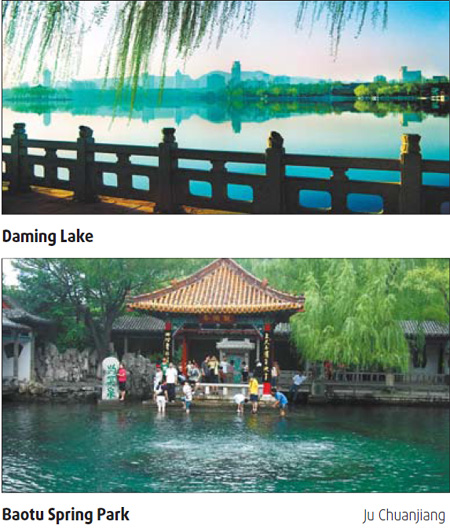Jinan: Eternal 'City of Springs'

With several hundred fresh water springs dotting the landscape of Jinan, capital of Shandong province, a local saying notes "each family in Jinan has spring water and weeping willows".
In the old city alone there are more than 140 springs, including the colorfully named Baotu, Black Tiger and Pearl springs, as well as the Five-Dragon Pool.
As early as the Song Dynasty (420-479), famed writer Zeng Gong commented that the Kingdom of Qi - one name for the area in ancient times - "crowned the world with springs".
Yu Qin, geologist in the Yuan Dynasty (1271-1368), said: "The mountains and rivers in Jinan top the Qi and Lu areas and springs in Jinan are the first." The Kingdom of Lu flourished in present-day Shandong about 3,000 years ago.
Jinan Mayor Zhang Jianguo notes the city "with more than 4,000 years of history is famed for its springs, which instill spirit into the city."
According to a government survey, there are 733 springs in and around Jinan. Of them, 136 in only 2.6 sq km of the old city produce at least 300,000 cu m of water daily.
Baotu Spring with 28 outlets is among the most robust. It was given the name by Zeng Gong, a poet of Song Dynasty(420-479), who combined bao, which means spring, and tu for rising high.
Parts of the spring are actually geysers that reach more than 25 m high and have a constant temperature of 18C year round.
Other noted springs include the Batu, the Black Tiger spring site known for its growling waterfall and Pearl Spring famed for its pearl-like bubbles.
Jinan's beauty has fired the imagination of many historical figures including poets Li Bai, Zeng Gong and Su Zhe, and emperors Kangxi and Qianlong in Qing Dynasty (1644-1911). They praised the springs while touring Jinan.
Due to the abundance of underground water, Jinan is home to more than 30 streets, 13 temples and 88 villages with "spring" as part of their names.
As well, several hundred underground springs provide the waters of scenic Daming Lake.
Not surprisingly, the waters attract millions of tourists each year.
Geologists say the reason for so many springs is due to thermal activity in mountains to the south and limestone formations that make it easy for water to find the surface over a wide range.
A Jinan city management office announced a bid three years ago to have the springs named to the Natural and Cultural World Heritage list.
The city has also begun preservation work by investing more than 2 billion yuan to build the Yuqing and Queshan reservoirs while bringing water from the Yellow River to conserve the springs in Jinan.
Some 2,500 underground wells have now been sealed to reduce the amount of underground water used each year by more than 24 million cu m.
Comments
Add your comments...
- Your Name Required
- Your Comment
- Comments are moderated and generally will be posted if they are on-topic and not abusive.
 0 Comments
0 Comments






